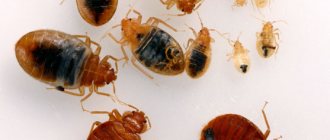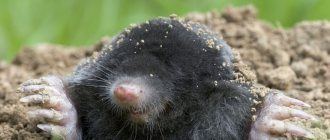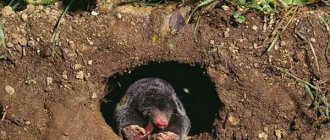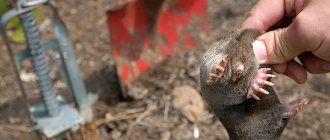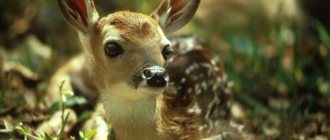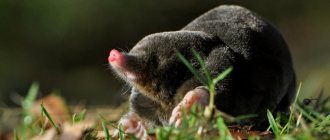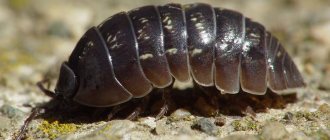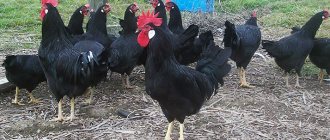By nature, male moles are inveterate loners, fiercely exterminating anyone who dares to settle on their territory. The mole begins to seek communication with the female exclusively during the mating season. One way or another, he will not be a good family man: having forced the female into his nest, he lives with her “under the same roof” for several more days, after which the female goes as far as possible from her husband. Having retired to a safe distance, the female bears offspring and builds her own nest. At the same time, as soon as the “father of the family” comes across him, he will happily feast on both his own cubs and the female. Filling the stomach with food is of primary importance for the mole.
What moles look like: photo
Migration and settlement of young moles
Little moles live together at first. Their natural aggression and quarrelsomeness appear later: towards the end of the first, beginning of the second month of life.
During the first few days of relocation, moles move through underground passages one after another: several at a time. Over the summer, enterprising farmers can catch up to 50 individuals with one trap, of which more than 70% will be inexperienced and naive young animals.
The speed of movement of moles through underground passages is up to 5-6 meters per minute, which allows them to quickly settle. In 20 hours, the young move up to 700 m. Moreover, only young individuals move so far; adult moles do not go further than 300-400 m over the next year of life.
When migrating, moles encounter various kinds of obstacles: rivers, streams. They are excellent swimmers: a stream 30 meters long, a mole can swim across in 3 minutes. When swimming, it raises its head high, scooping the water to the sides with its powerful front paws and in front of it with its hind paws. The railway embankment is not an obstacle for the mole either: they easily cross highways, highways and railway tracks.
The only thing moles don't like is wetlands. The main principle by which they choose their migration route is the suitability of the land for digging and a sufficient amount of food (mainly invertebrates) . They usually settle along the edges, forest clearings, and forests. In search of an uninterrupted source of food, they also enter human agricultural holdings. Exterminating moles is counterproductive, because they eat garden pests, thereby preserving the harvest. Of course, countless underground passages can disrupt the root system of plants: in this case, you can scare off moles from the site using homemade devices or ultrasonic repellers.
Description
The cubs are born naked, blind, and toothless. Their weight is up to 3 g. Babies have an excellent appetite. They gain weight quickly. After 7 days, soft yellow fluff appears on the body and the eyes begin to open.
The appearance of the baby is influenced by the period of growing up. It doesn't look very attractive in the first week. The body is pink without hair. After 2 weeks, the animals become cute creatures with short fur, as well as small round eyes and large front paws
Having reached the age of one month, they can be safely compared with an adult. The length of the animal reaches 16 cm, the length of the tail is up to 4 cm. Weight – 120 g.
Why do they think that the mole is blind?
- If you take a quick look at the mole, you may not notice its eyes at all. Both eyes and ears are completely covered with fur. On the mole's face, only the nose stands out well. And since they couldn’t find the eyes, they decided that the animal was blind.
- Sometimes a mole may not pay attention to a person, being carried away by hunting insects. This fact also confirms the incorrect opinion that the mole is blind.
- The mole rarely appears on the surface of the earth and then mainly at night. So it turns out, why does he need eyes? Moreover, when making moves underground, dirt can get into your eyes.
In fact, the mole constantly uses its eyes. He always moves away from bright light, notices an uninvited guest in his hole, reacting to movement. On the surface of the soil it can notice and catch prey that is moving. A mole needs vision and helps it survive in quite difficult conditions.
Breeding period
Moles: masters and aggressors.
Animals lead an underground lifestyle. The mating period involves leaving the burrows to search for a mate. Males often fight for the female.
The mating season falls in April and May. The gestation period varies from a month to a month and a half. The duration of this period depends on the type of animal. Accordingly, they are born in June or July. One litter consists of 3 – 9 cubs.
Females are not particularly fertile. There can only be one litter per season. The appearance of a second offspring is very rare.
Types, photos of moles
The Mole family (Talpidae) consists of 42 species in 17 genera of three subfamilies. Relatives of moles are muskrats (subfamily Desmaninae), which lead a semi-aquatic lifestyle.
Today in the subfamily Moles (Talpinae) there are 40 species in 15 genera. They are common in Europe, North America and Asia. Not found at all in Africa.
Several species live in Russia: 4 species from the genus of common moles (Talpa) and 2 from the genus Mogera (Mogera).
The Siberian mole (T. altaica) is found from the Irtysh River to Transbaikalia.
Siberian mole
The Caucasian mole (T. caucasica) and small mole (T. levantis) live in the North Caucasus.
Caucasian mole
There are two species of eastern moles living in the Far East - the Ussuri mogera (Mogera robusta) and the Japanese one (M. wogura).
Mogera ussuriensis
But the most famous and widespread is the common (European) mole (Talpa europaea), whose habitat covers the forest and forest-steppe zones of the Russian Federation and partly Western Siberia.
There is a lot in common in the biology of different species of moles - they are all underground inhabitants, arranging extended galleries that serve for moving and collecting food, nesting chambers and storage areas for supplies. Unlike rodents, which use their teeth to dig the ground, all moles dig the ground with their front paws and are more sensitive to the hardness of the soil, which limits their spread and the depth of their galleries. The forelimbs of animals are perfectly suited for digging. The hands are very wide, almost round with five large powerful claws. Turned in a vertical plane with the palm facing outward, they resemble a pair of oars. The least strong paws are those of eastern moles, which live only in loose layers of soil and in litter, and do not make molehills.
The fur of moles is short, uniform in length and does not interfere with the animals’ movement in underground passages in any direction. Only the Chinese shrew species have hard spine fur, so they cannot move backwards in an underground tunnel. The fur color is uniform, usually brownish-black or gray.
Common mole
The most famous representative of the genus of common moles (Talpa) is the common mole itself, also known as the European mole (Talpa europaea).
The body length of the animal is 12–16 cm, weight 70–120 g. The body is roll-shaped, the tail is short. The muzzle is elongated and flattened. The eyes are very small. The hands are wide, edged with bristly hairs and flat claws, approximately equal on all fingers. The forelimb bears additional lateral bones on the side of the bases of the fifth and first fingers. The hands are turned with the palms back.
Common mole (Talpa europaea)
Thick and short velvety fur stands almost vertically, which allows the animal to move in narrow passages in any direction. Due to constant friction against the walls of the burrows, the mole's fur quickly wears out, so there are 3-4 molts during the year.
The common mole inhabits the forest and forest-steppe zones of Europe and the Trans-Urals from the north of the Iberian Peninsula to the south of Western Siberia. He prefers to settle in areas with forest vegetation and tries not to go out into open spaces. The main condition for existence is moderately moist soils rich in humus. Avoids areas with marshy and sandy soils.
Leads a solitary lifestyle. Each animal occupies a certain area and builds its own system of burrows. It is completely intolerant of the presence of individuals of its own species. Usually sedentary, but young moles during the settlement period move 1–4 km from their place of birth.
The mole makes its nest in dense soil, usually under tree roots, stumps or other objects protecting from above. The animal is characterized by polyphasic daily activity - periods of feeding are replaced by short periods of sleep, about 4 hours. The time spent awake depends on the abundance of food.
The mole has a high metabolic rate and is forced to eat quite often; after 10–12 hours of fasting, it dies.
Active all year round. In winter, it usually feeds in the ground layer of snow, partly by mining the forest floor, partly by digging tunnels in the snow.
The basis of the diet is earthworms. It also eats other invertebrates, mainly insects and their larvae; on occasion, it catches small rodents, lizards, and frogs caught in its passages.
Reproduction begins in March–April. The duration of pregnancy is about 40 days. There is 1 litter of 3–9 cubs per year. Newborns are naked, blind and helpless, but they grow very quickly, and within a month they already reach the size of adults. At the age of 1–1.5 months, the young disperse.
The lifespan of moles is 4-5 years.
Japanese shrew mole
Genus Japanese shrew moles (Urotrichus) are sometimes classified as a separate subfamily; less often approach American shrew moles (genus Neurotrichus). There are 2 species in the genus (sometimes each is classified as a separate genus). In appearance they resemble shrews with a bushy tail, but the forelimbs are digging, and the eyes are hidden under the skin.
The Japanese shrew mole (Urotrichus talpoides) lives on the Japanese islands of Honshu, Shikoku, Dogo and Tsushima. Found in forests and meadows with tall grass.
Japanese shrew mole (Urotrichus talpoides)
Body length is 5–10 cm. The front part of the muzzle is greatly elongated, the long movable proboscis is covered with vibrissae. The ears are small. The hands of the forelimbs are only slightly widened. The tail is quite long and pubescent. Sometimes fat reserves are deposited in the tail.
Very common in suitable biotopes. It makes passages in the litter and upper layers of soil, actively moves in search of food also on the surface of the ground, sometimes climbing low trees and bushes. In winter, these animals are sometimes found frozen in birdhouses hanging at a height of 2–4 meters. Unlike ordinary moles, they are quite tolerant of representatives of their own species.
Reproduction occurs in April–May. The female brings one litter per year, usually consisting of three cubs.
Star-nosed mole
Star-nosed moles, or star-nosed moles (genus Condylura), living in North America, are very similar in structure to an ordinary mole, but have a long tail, and prefer to search for their prey by actively swimming and diving in the water.
This species boasts a unique nose, divided into many small tentacles that resemble coral in appearance. The tentacles are covered with thousands of receptors and help the mole in searching for food.
In the photo, the star-nosed mole shows off its amazing nose.
Star-nosed mole
If most species prefer a solitary lifestyle, then the starfish is an exception to this rule. In this species, the male and female can live together during the winter.
Mature offspring
At 1.5 – 2 months the baby mole becomes an adult. It can kill mice, frogs, snakes. Mature individuals are aggressive towards each other. On the 35th day they can leave the nest in search of a new home. At this moment, animals often die from attacks by predators or are hit by cars.
At 2 months they build a separate burrow with numerous labyrinths. The animal is capable of plowing up to 45 m of land in a day. The volume of the daily diet is equal to its own weight. The mole is looking for food to stockpile.
The pest eats several times a day. The digestion process takes up to 5 hours. He sleeps between meals. The diet consists of:
- worms;
- caterpillars;
- woodlice;
- larvae;
- slugs;
- snails;
- mole cricket;
- spiders;
- centipedes.
Natural enemies of moles include cats, dogs, foxes, wolves, and hedgehogs.
Arrangement of the nest
The female builds a nest for the future offspring away from the “spouse’s” burrows. The new mole hole is located at a depth of one and a half to two meters and consists of numerous radial and circular passages. The new dwelling communicates with the old circular gallery of holes.
To protect children from the possible danger of attack and to provide an escape route, the nest is built at the intersection of several underground passages. The nests look like small closets covered with soft grass, leaves or moss.
The habitat area of an adult mole is about 50 hectares. A brood can occupy an area of up to 1250 hectares. To avoid encroachment on its territory, it is marked with a special secretion accumulated on the belly fur. An area not marked with a secret is considered free for settlement.
In search of a comfortable place to live, moles constantly move from place to place. During floods, they move to higher ground, and as the heat sets in, they move to cooler lowlands. In hot weather, moles can go a considerable distance from the house in search of water. At the same time, throughout their lives, they remain in the area of their site.
A friendly neighborhood is not accepted among moles. If a mole living nearby dies or gets caught in a trap, the neighbors immediately notice and expropriate its territory.
Duration and lifestyle
In the wild, a mole lives from 2 to 5 years. The offspring almost always survive due to the absence of enemies underground. The duration of pregnancy and the birth of one litter preserves the females' health and vitality. The life expectancy of males and females is the same.
Young moles are very affectionate. However, as they grow up, they become grumpy and pugnacious.
Adults engage in fights. They tend to bite the enemy to death. They are incapable of empathy. When there is danger and threat of death, they do not come to the rescue. In such cases, they settle in the burrows of the dead. Only the mating season can force them to unite.
Live in the dark
Labyrinths can be at different depths. It depends on the type of soil. In loose and wet soil, make small depths for burrows, and in dry soil - more than 20 cm.
Most of the time they spend time digging
Under the forest path the animal makes the deepest tunnel. The nest is located at least 1.5 m from the ground surface. It is lined with leaves and grass.
Seasonal movement
In summer they choose lowlands, in spring they prefer highlands. In spring, males tend to expand their home. This is due to the fact that the search for a female begins.
Moles have poor eyesight. Underground this is not particularly important. They are afraid of sunlight, but distinguish between:
- contrasting colors;
- light from darkness;
- objects in motion;
- large items.
Ever seen a live mole?
Never happened
If a mole has settled on the site for the first time, gardeners need to act quickly and effectively. First, recognize the enemy by sight, then move on to protecting property.
Plants are a safe way to protect your area from moles and other rodents.
Mole traps allow you to catch the pest quickly and easily.
The greenhouse requires protection from moles; they are comfortable there at any time.
Proven methods of controlling moles on the site. Fast and efficient.
Are moles blind from birth?
There is an opinion that moles are blind, but they see, but very poorly. Underground, vision is not particularly important, since it is still dark there.
Moles do not like sunlight, but they are able to:
- distinguish some contrasting colors;
- distinguish darkness from light;
- notice moving objects;
- see large convex objects.
Moles can only distinguish objects within a radius of about two meters. The statement that moles are blind even though they have eyes and poor vision is incorrect.
“Little Mole...” through the eyes of a publisher: “Why did we decide to publish this book?”
In a children's book, the artist plays a vital role. Wolf Erlbruch, who drew “The Little Mole...”, is a very famous book illustrator. Before I saw the book about the mole, I thought that Erlbruch drew for adults. But “The Little Mole...”, from the point of view of drawing, is a wonderful children's book. She is already 20 years old. It is always among the bestsellers in bookstores in Germany, England, and Spain. It is published in two formats - small, like ours, and larger. However, most Moscow stores refused to sell Little Mole. They said they were afraid of how customers would react. The theme of the book seemed “strange” there. That is, they simply considered it indecent. But when we made the decision to purchase copyrights, the topic did not bother us at all - because here it is presented very talentedly. In addition, it seems to me that “Little Mole...” is a book with good educational potential. I remember how my grandmother taught me as a child: “Look, a cow passed here. And this goat left her mark. And here was a wild boar...” It was all so interesting to me! What's the end of this book? Firstly, again, there is a very precise natural scientific observation: flies are the best at figuring out “who did this.”
Secondly, as a result of the “investigation” carried out by the little mole, justice is restored: the offender is punished. But, mind you, being punished is not scary at all. Most likely, he will not even notice this punishment. It's not painful. By and large, it is not offensive. But the mole had to do this in order to maintain his own dignity. Isn't that important? On the Labyrinth website, among the reviews of this book there were no swear words! But, remember, as Munchausen said in Zakharov’s film: “All the stupid things in the world are done with a serious face. Laugh, gentlemen, laugh!”
Maria Melik-Pashaeva
"Little mole..." from a naturalist's point of view
This simple story is a good reason to talk with your child about what he is learning about himself and the world around him one way or another. Talk in very simple language, looking at the funny details of the illustrations and noting our natural caution towards any excrement. Talk about tiny special microbes that help us grow and gain strength from food. That they are not visible because they are very small. But if there were no microbes left inside us, our weight would immediately decrease by several kilograms. When germs live in their usual place, this is good, but when they get into the mouth or eye, they can get sick. Therefore, you need to wash your hands after walking, using the toilet and before eating. That is why we carefully wash vegetables, fruits, and herbs that we have picked or bought in the store. It is known that doctors, experienced parents and pet owners can identify illnesses by the sight and smell of excrement. I remember one mother’s story about the horror she experienced when she first fed her child beets. I think that these features of changes in urine and feces also need to be told to children in an easy and simple way. By the way, this is also a good reason to tell your child that the word “poop” is a household word, doctors call them feces, biologists call them droppings, and in general all these body secretions are called the scientific word “excrement.” Naturalists, trackers and biologists know what prints of paws, legs, wings, teeth and beaks and food remains - the so-called gnaws and pellets - look like. Animal droppings are part of this long list of traces by which you can find out what happened: who dined here; who sat on this hummock at dawn, and who ran across the path in your garden. And who clearly marked their territory here? Usually we don’t see all these animals, they live their own lives, and we must respect their right to this life of theirs. Therefore, it is better not to pick a hedgehog out of its hiding place in order to place it in an apartment, but to learn to recognize the presence of animals by their various tracks. It's so mysterious and interesting! Of course, the question may arise, do we, city dwellers, need all these details of the diversity of animal droppings? If we are not going to study animals, move to the taiga, or hunt, then probably not. And for children who are learning to use a potty instead of a diaper and walk through our yards and parks instead of a stroller - perhaps yes. This is the level of surprise that everyone around us is different and so different. And they all eat and poop. I think that interest in knowledge begins precisely in such a unafraid childhood, when everything around you causes surprise and questions that are not answered with an immediate ban: “Ugh, what disgusting! In polite society they don’t talk about such things!”
I was a little confused by the ending of the book: why did the mole not even talk to the dog, but immediately believed the flies? Why did you smack your little mark on his forehead and calm down? Yes, but why did I decide that the offended mole is a model and a hero? After all, what do offended people not do? And moles, apparently, too. So with this ending, we just had a reason to discuss possible options and reflect. I also liked how the mole wears an as-yet unidentified poop on his head. In the cartoon, when he greets a cow, he also lifts it up like a hat. But most of all I liked the author’s proposal to respect children’s interests.
Nadezhda Pantyulina, employee of the State Biological Museum named after K.A. Timiryazeva
Do you want to watch a cartoon? Perhaps he will reconcile you with the book: https://www.youtube.com/watch?v=_XwMESXpA3o&feature=related https://www.youtube.com/watch?v=e1EMZGFHu_Y
The book by A.N. will help you learn to read animal tracks. Formozov "The Pathfinder's Companion"
"Little Mole..." through the eyes of foreign readers
The book about the little mole was first published in 1989. It has been translated into almost 30 languages. It is discussed both on Internet forums and on bookselling sites. But foreign readers react to it not at all as sharply as users of the “Russian” Internet. Of course, there are those in Western networks who (for more than 20 years now) are outraged by the very topic of the book. There are also users who believe that books for children that talk about the natural functions of the body have a right to exist, but should serve a purely practical purpose - to potty train a child. The main complaint about the book is related to the ending of the story: they say, it teaches the child to take revenge, to follow the principle of “an eye for an eye.” But there are relatively few such reviews. For example, on one German website the book received a rating of “five” 98 times and a rating of “one” only 7 times. Website visitors consider the main advantage of the book to be that the book is very funny. And it’s funny for both adults and children. They also note that a children's book does not necessarily have to contain deep morality. Adults often read just for fun, and children have that right too. And many parents find a way to make this book useful: with its help, they teach children to identify animals by the “traces” they leave, talk about why these “traces” are so different, about where which animals live and what they eat. Parents write that the mole's revenge on the dog in this book is, first of all, funny. The little mole takes revenge on the huge sleeping dog, who, upon waking up, is unlikely to notice anything, and therefore will not know that he has offended the mole. Someone, however, after reading the fairy tale explains to the child that it is better not to take revenge, but to talk to your offender. Some parents note that this fairy tale is replete with euphemisms and onomatopoeia, so reading has a positive effect on the development of children's speech. And adults get an additional reason to talk with the baby about language.
Parents of children who had problems with reading write: the book is not serious, but interesting for any child. “The Little Mole...” helped our child start reading on his own. Examples are given of the positive impact of the book on children who, for some reason, were afraid to go to the toilet or suffered from neurotic constipation. As a rule, such children also have problems talking about a topic that is painful for them. And if you read this book to your child several times, the topic is “legalized” and ceases to be painful and frightening. It’s as if the child gets the right to call things by their proper names. This helps to combat the problem itself. And one review even says that this book was read aloud to students in class by a college professor, illustrating the positivist approach to scientific inquiry adopted in the 19th century!
Prepared by Elizaveta Prudovskaya Based on materials from the sites amazon.com, amazon.co.uk, amazon.de
Nutrition
Females are caring mothers who carefully look after their cubs. Initially, mole babies feed on milk, quickly gain weight, and develop. In about a month, teeth grow, claws grow, the cubs switch to solid food - grain, seeds, roots, insects, earthworms.
At the age of 1.5-2 months, the cubs become independent and are capable of killing a mouse, frog, or snake. The matured young animals behave aggressively towards each other; after 60 days of their existence, each of them begins to build their own burrow with numerous labyrinths.
Baby's diet
During the day, the animal plows about 45 m of soil with its paws. Eats in one day an amount of food equal to its own weight. Constantly in search of food, makes numerous reserves. By the number of hillocks with a mound of soil above the ground, you can determine the trajectory of the burrow.
The baby mole feeds several times a day. Food is digested in approximately 5 hours. Between breaks in food, the animal sleeps in a special “room” curled up in a ball.
Basic diet:
- earthworms;
- caterpillars;
- woodlice;
- May beetle larvae;
- slugs;
- snails;
- mole crickets;
- spiders;
- centipedes.
Occasionally they eat vertebrates that are in a sedentary state - mice, lizards, snakes, frogs. In a hungry state, an animal can live no more than 17 hours.
Nutrition
Females are caring mothers who carefully look after their cubs. Initially, mole babies feed on milk, quickly gain weight, and develop. In about a month, teeth grow, claws grow, the cubs switch to solid food - grain, seeds, roots, insects, earthworms.
At the age of 1.5-2 months, the cubs become independent and are capable of killing a mouse, frog, or snake. The matured young animals behave aggressively towards each other; after 60 days of their existence, each of them begins to build their own burrow with numerous labyrinths.
Baby's diet
During the day, the animal plows about 45 m of soil with its paws. Eats in one day an amount of food equal to its own weight. Constantly in search of food, makes numerous reserves. By the number of hillocks with a mound of soil above the ground, you can determine the trajectory of the burrow.
The baby mole feeds several times a day. Food is digested in approximately 5 hours. Between breaks in food, the animal sleeps in a special “room” curled up in a ball.
Occasionally they eat vertebrates that are in a sedentary state - mice, lizards, snakes, frogs. In a hungry state, an animal can live no more than 17 hours.
Why are moles dangerous for crops?
Since moles massively destroy earthworms in the garden, the lack of the latter leads to insufficient loosening of the soil, which negatively affects the development of plants and their productivity.
Some plants die due to the fact that the roots fall into the mole entrance and remain, as it were, hanging in the air, not receiving nutrients.
What's the use
Moles eat mole crickets and beetles in the garden, which are dangerous insect pests. In addition, they feed on voles.
Medvedka
Number and economic importance
Moles are ubiquitous and are not a protected species. This is one of the few insectivores that was important as a fur-bearing species. Since the 19th century durable, velvety moleskins were mined in large quantities. Currently, for economic reasons, the mole has almost no commercial significance.
Moles bring benefits by exterminating harmful insects and changing the structure of the soil - loosening it and enriching it with organic matter. Long-term digging activity of moles leads to improved soil; Excess moisture goes through molehills to lower soil horizons. At the same time, the mole is considered a pest of agriculture, gardening and horticulture. Digging its passages, it damages the roots of plants, thereby disrupting their normal nutrition and often causing death. Moles also destroy earthworms that are beneficial to the soil. They fight moles with a wide variety of methods, including using pungent odors (by placing chopped onions, garlic, rags soaked in kerosene, etc.) or sound signals (turntables, reeds, ultrasonic devices, etc.) in the mole passages.
How to get rid of moles on the site
Various means are used to combat these animals:
- It is known that the smell of wormwood is very unpleasant for moles. Therefore, where it grows, these animals try not to appear.
- Another means of control is to spray garden bushes and trees with a solution that includes peppermint oil.
- If legumes are planted on the site, then this land will not be suitable for moles. The same can be said about planting onions and garlic. If you plant the borders of the site with these crops, then moles will not live there.
- It is believed that if you plant the imperial hazel grouse, it will help get rid of these animals.
- An effective means of controlling moles is the use of traps. A dog can help you install them correctly. The smell of mole enzymes is very unpleasant to them and they can distinguish the smell well. The dog will help you find the exit of the wormhole to the surface. Usually it is covered with earth. Therefore, before installing a trap, you need to remove a pile of earth above the surface and dig a little deeper into the hole. You need to install a trap at the exit from it. Since this passage is dug, the mole will feel a draft and will come to cover the exit from the hole with earth. At this moment he will fall into a trap. If the hunt for the mole ended successfully, then it may still be alive. If a mole hunter adheres to humane views of them, then he has the opportunity to take the animal and take it far into the forest or field and release it there. If the mole is dead, then it must be buried. This must be done away from sources of drinking water.
- Another option to get rid of moles on your property is to use sound repellers. There are two options for such devices:
- reed;
- using plastic bottles.
Where does the mole live?
Photo: Soil animal mole
Representatives of the mole family are widespread. They live throughout Eurasia and North America. In South America, moles are completely absent. Scientists have concluded that these animals settled in North America when it was separated from the South by the Strait. Moles live in especially large numbers in Russia, Belarus, Poland, Ukraine, Georgia, and Moldova.
In particular, four species of moles live in Russia:
- Blind. It is distributed from Ciscaucasia to Transcaucasia. Representatives of this species can often be found in Turkey and even in Northern Iran. The animal lives in mountains, alpine meadows, and is sometimes found in forest landscapes. To live, blind moles choose loose, moist soils. Sometimes these animals live together with the Caucasian species;
- Caucasian. It settles in the central, western parts of the Caucasus, and is found in some areas of Turkey, which are adjacent to the shores of the Black Sea. Caucasian moles live mainly in deciduous forests, but in small numbers they are found in mountain meadow biotopes. In search of food, such animals can go to a depth of up to one meter. The main passages are located quite close to the surface - at a distance of five centimeters;
- Altaic. It has a uniform coat color, the fur on the belly is matte. The appearance of Altai moles is completely consistent with moles. The body of the animal is quite massive and round;
- Ordinary. This is the group of the most common moles. Its representatives can be found in various landscapes: from forests to mountains.
For a normal life and reproduction, moles need special conditions. For this reason, they choose areas with moist soil. It is most suitable for digging tunnels. The terrain of the area can be almost anything. The animals prefer a moderate climate.
Starfish
Known under the names star-nosed mole, star-nosed mole, star-nosed mole, star-nosed mole. In appearance it is similar to most other moles, but differs in its elongated tail (6–8 cm) and hard fur that does not get wet. There are two skin growths on the face, similar in appearance to an asterisk, which is where the name of the individuals comes from. Animals in adulthood weigh up to 85 g. The eyes are small, but clearly distinguishable in appearance. Lives in the eastern regions of North America.
Western American
The body length of the animal is 11–14 cm, while the tail can take up to 5.5 cm. Body weight reaches 170 grams. The proboscis of the muzzle is moderately elongated. The eyes are small, hidden under the fur. There is no external auricle. The hand of the foot is very wide. The tail is thick, covered with sparse hairs. Distributed in North America.
A small species of the Mole family. Lives in China.
Long-tailed
Lives in Asia. Body length 7–9 cm, weight up to 12 grams. There are no auricles. The front legs are slightly widened and equipped with almost straight claws.
Distributed in the Chinese province of Sichuan. It lives mainly in forests of the temperate zone.
Caucasian
Outwardly, it almost completely resembles a European mole. It stands out only for its rudimentary eyes covered with thin skin. It has large teeth and velvety fur. It can burrow to a depth of 1 m. It eats up to 40 g of food per day.
Blind
The smallest mole in our country with a body length of 8–12 cm, weight – no more than 30 grams. The eyes are covered with thin skin. Tail length is about 3 cm.
Japanese mogera
It lives in the southern territories of Japan, as well as in China, Korea and the south of Primorsky Krai. Prefers to live in cultivated fields and meadows.
Interesting facts about moles
Moles are the masters of the home. They usually find a place to live under the roots of trees. When setting up a house, moles cover it with grass and leaves. They do not like to change their place of residence. The moves that the mole makes differ in their purpose. One by one he goes to his hole and to the watering hole, and all the others serve to get food.
For the winter, the mole stores food. He collects all the invertebrates, mutilates them, leaving them alive so that they cannot escape and puts them in a pile.
Moles are selfish animals. They can only exist alone. Even during the mating season, they have difficulty finding a female. When hunting for a female, fights often occur. Having met, two males begin a fight and fight to the end until one of them dies. The survivor then eats the dead mole.
Historical fact. Valuable mole fur skins were used to protect pilots' faces from frostbite. In winter, on airplanes with open cockpits, pilots wore face masks made from soft moleskin. It perfectly protected pilots from cold and wind.
In conclusion, it should be said that moles are secretive animals and their habits have been little studied.


